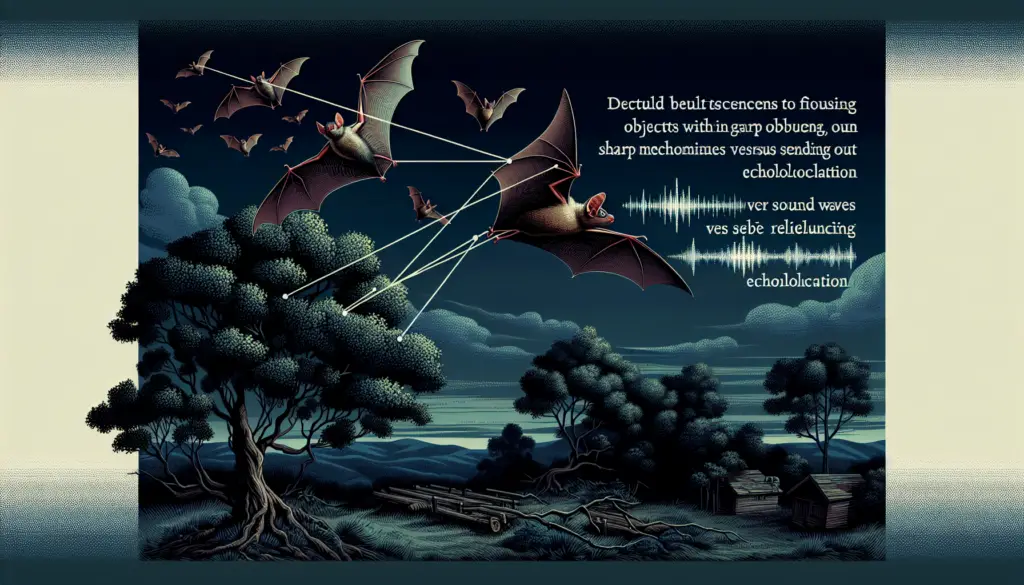Bats have always fascinated me with their mysterious nocturnal lifestyles.
You might be wondering whether bats have good eyesight or if they rely solely on echolocation to navigate the night skies.
Contrary to popular belief, bats do have good eyesight, and they use both vision and echolocation to perceive their environment.
The Truth About Bat Vision
Table of Contents
ToggleMany people think bats are blind, but that’s actually a myth.
Bats can see quite well, especially in low-light conditions.
Their eyes are adapted to function in the dark, much like the eyes of other nocturnal animals.
Some species of bats can even see ultraviolet light, which helps them find food and navigate.
How Echolocation Complements Their Vision
While bats have good eyesight, echolocation is a special skill that gives them an edge in total darkness.
They emit high-frequency sounds that bounce off objects, allowing them to create a mental map of their surroundings.
This ability is crucial when hunting insects at night or navigating through dense forests.
Echolocation works so well for bats that they can detect objects as thin as a human hair.
Do All Bats Use Echolocation?
Not all bats rely on echolocation to the same extent.
Fruit bats, for example, have excellent vision and a keen sense of smell, which they use more than echolocation.
These bats are active during dawn and dusk when there is still some light available.
In contrast, insect-eating bats depend heavily on echolocation to catch their prey in complete darkness.
The Role of Vision in Bat Behavior
Bats use their eyesight for more than just navigation.
They rely on vision for social interactions and recognizing roosting sites.
During twilight hours, bats may use visual landmarks to return to their caves or nests.
Visual cues also help them identify other bats within their colony.
Misconceptions About Bats Being Blind
The saying “blind as a bat” is misleading and doesn’t reflect reality.
This myth likely arose because bats are active at night and use echolocation.
In truth, bats have eyes that are well-suited for their nocturnal habits.
Understanding this helps us appreciate how adaptable and sophisticated these creatures are.
How Bat Eyesight Compares to Other Animals
Bats have vision comparable to that of humans in low-light conditions.
Their eyes contain rods that are sensitive to dim light, enhancing their night vision.
They may not see as sharply as diurnal animals, but their eyesight is sufficient for their needs.
Combined with echolocation, bats are well-equipped to handle their environments.
Echolocation vs. Vision: When Bats Use Each Sense
Bats switch between echolocation and vision depending on the situation.
In open spaces with some light, they might rely more on eyesight.
In cluttered or dark environments, echolocation becomes more important.
This flexibility allows bats to adapt to various habitats and hunting conditions.
The Importance of Echolocation in Hunting
Echolocation is essential for bats that hunt fast-moving insects.
It allows them to detect and capture prey with incredible precision.
Bats can adjust the frequency of their calls to gather more detailed information.
This skill is a remarkable adaptation that sets them apart from many other animals.
How You Can Observe Bat Behavior
If you’re interested in bats, consider visiting areas where they are known to roost.
Places like caves, forests, and even urban parks can be good spots.
Remember to respect their habitats and avoid disturbing them.
Learning about bats can deepen your appreciation for these unique creatures.
Protecting Bat Habitats
Bats play a crucial role in ecosystems by controlling insect populations.
Protecting their habitats ensures they can continue to thrive.
Supporting conservation efforts helps maintain the balance of nature.
You might even consider installing a bat house to provide them with a safe roosting site.
Final Thoughts on Bat Vision and Echolocation
Bats are not blind and have adapted to use both sight and sound effectively.
Understanding this enriches our knowledge of the natural world.
Next time you see a bat fluttering in the evening sky, you’ll know it’s using a combination of senses to navigate.
These fascinating mammals truly are masters of the night.
If you’re curious to learn more about different bat species, you might find the variety of bats that inhabit our world quite intriguing.



